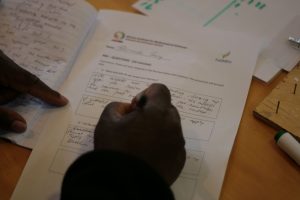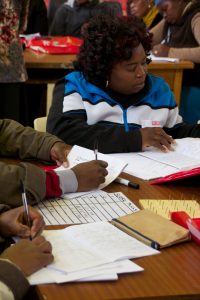AIMSSEC runs two residential courses for mathematics teachers each year. At the course in July 2014, which took place in Stellenbosch in the Western Cape, there were two groups of teachers: those studying towards the Advanced Certificate in Education (ACE) and those studying on the Mathematical Thinking (MT) course.
FaSMEd was given the opportunity to work with all the teachers on the MT course (102 teachers) in a 90 min plenary session and were asked to make the mathematical focus broadly on the topic of ‘Data Handling and Probability’.
The research focus of the session was on formative assessment within the mathematics classroom, and the session was used to gather data and model a particular teaching approach which might provide opportunities for formative assessment.
Four staff members ran the session: Michael Andrews and Krista Nordin, who were visiting interns from the Massachusetts Institute of Technology (MIT) as well as Ingrid Mostert and Marie Joubert from AIMSSEC. The group planned collaboratively a) what data to gather b) how to gather the data and c) the ‘model lesson’. KN took responsibility for the data gathering instrument and MA took responsibility for the teaching.
The outline plan for the meeting was:
- Introduction and ethical clearance forms – 5 minutes (MJ)
- Individual work on questionnaire – 10 minutes (KN)
- Whole group discussion – 5 minutes (IM)
- Model lesson – 40 minutes (MA)
- Return to questionnaire -15 minutes (MJ)
- (slippage 5 minutes)
FaSMEd’s main pedagogic interest is in formative assessment, and fasmedSA was keen to explore teachers’ understanding of this. KN and MJ designed a questionnaire to be used at two distinct points in the session: at the beginning to provide some baseline data and again at the end in case teachers wanted to add anything. It was felt important that the teachers did not feel ‘tested’ and were provided with the opportunity to review, or add to, their responses later in the session. For this reason two response boxes were provided: one for the beginning of the session and one for later on.

Analysis of the responses is ongoing but observations suggest that most participants understood the questions, had enough to write and were very willing to contribute. Ingrid led a short discussion on when and why teachers assess their learners and on the different sorts of assessment that can be used in classrooms. She discussed the term ‘formative assessment’, emphasising the this is the process of acting on the information received by the assessment instruments (e.g. oral questioning, posters, tests).

For the mathematics, Michael decided to focus on probability and in particular the likelihood of getting different totals when two die are thrown. For example, if one dice shows a 2 and the other shows a 6, the total is 8. In his view, the success of this activity depends on an understanding that, when a fair dice is tossed, it is equally likely to fall on any of the six sides. In order to model formative assessment, Michael wanted first to demonstrate the important idea of finding out what the learners already know. He therefore began by establishing that the teachers were secure in their understanding that the probability of tossing any of the six numbers is 1/6, also explaining why he was doing this.
He asked the teachers to work in small groups to toss two die, and to create tally tables of the total scores each time.

Whilst they were doing this the AIMSSEC staff observed what small groups were doing and listened to their discussions. After it became clear that most groups understood that some totals were more likely than others, the group came together to share their findings and explain the mathematics of the exercise.
To finish off, the group returned to the questionnaire; first considering where there may have been opportunities for formative assessment in the model lesson they had just been involved in and then returning to the first two questions to add further remarks.